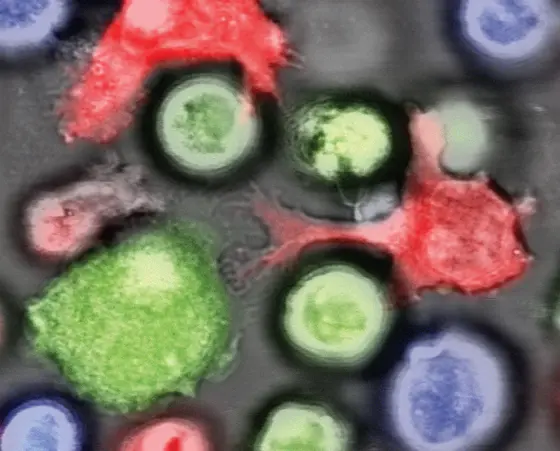Patients with acute myeloid leukemia (AML) often relapse after apparently successful treatment. Leukemia stem cells that survive the therapy are responsible for the return of the disease. Scientists can partially explain this phenomenon: The stem cells have protective mechanisms that make them resistant to chemotherapy. But how do they manage to escape the immune defense?
A team of scientists from the University Hospitals of Basel and Tübingen, the German Cancer Research Center (DKFZ), the Heidelberg Institute for Stem Cell Technology and Experimental Medicine (HI-STEM)* and the German Cancer Consortium (DKTK) have now investigated this phenomenon and discovered a surprising mechanism.
The researchers analyzed the leukemia cells of 177 AML patients and found that the cancer stem cells lack expression of NKG2D-L proteins on their surface. These proteins enable the natural killer cells (NK cells) to recognize and kill damaged and infected cells as well as cancer cells. By suppressing NKG2D-L, the leukemia stem cells escape destruction by the immune system. Leukemia cells without stem cell properties, on the other hand, present these target molecules on their surface and can therefore be targeted by NK cells.
Using mice to which AML cells from patients had been transferred, the researchers showed that only AML cells without stem cell properties were controlled by the NK cells, while the NKG2D-L-negative leukemia stem cells escaped the killer squad. “Such a connection between stem cell properties and the ability to escape the immune system was unknown until now,“ said Claudia Lengerke from the University Hospital of Basel and the University of Basel. “An essential mechanism of this immune resistance in leukemia stem cells is apparently the suppression of danger signals such as NKG2D-L on the cell surface,“ added Helmut Salih from the University Hospital of Tübingen and the German Cancer Consortium DKTK.
What is behind this extraordinary protective mechanism? The scientists noticed that leukemia stem cells produce a particularly high amount of PARP1, an enzyme that blocks NKG2D-L production. Preclinical experiments with mice transplanted with human leukemia cells showed that PARP1 actually plays an important role in immune escape: treatment of these animals with drugs that inhibit PARP1 induced NKG2D-L expression on the surface of the leukemia stem cells which as a consequence were then recognized and eliminated by transferred human NK cells.
Cancer therapies involving the immune system have been successfully applied for many years in the form of allogeneic stem cell transplantation in AML patients in certain disease situations. In recent years, further novel immunotherapeutic approaches have been developed which are currently being clinically tested in different cancers. “Our results show how cancer stem cells cleverly trick the immune system. The elucidation of the underlying mechanism now makes it possible to counterattack,“ says Andreas Trumpp, German Cancer Research Center and HI-STEM.
The results provide the basis for the possibility of combating malignant leukemia stem cells by combining PARP inhibitors with active NK cells. The scientists involved are now planning to evaluate this approach in a clinical study.
The work, which has now been published in the journal “Nature“, was carried out from the research groups headed by Claudia Lengerke (Department of Biomedicine and Clinic for Hematology at the University and University Hospital of Basel), Helmut Salih (University of Tübingen and German Cancer Consortium (DKTK), and Andreas Trumpp (German Cancer Research Center, HI-STEM and DKTK).
*The Heidelberg Institute for Stem Cell Research and Experimental Medicine (HI-STEM) gGmbH was founded in 2008 as a public-private partnership between the DKFZ and the Dietmar Hopp Foundation.
Anna M. Paczulla, Kathrin Rothfelder, Simon Raffel, Martina Konantz, Julia Steinbacher, Hui Wang, Claudia Tandler, Marcelle Mbarga, Thorsten Schaefer, Mattia Falcone, Eva Nievergall, Daniela Dörfel, Pauline Hanns, Jakob R. Passweg, Christoph Lutz, Juerg Schwaller, Robert Zeiser, Bruce R. Blazar, Michael A. Caligiuri, Stephan Dirnhofer, Pontus Lundberg, Lothar Kanz, Leticia Quintanilla-Martinez, Alexander Steinle, Andreas Trumpp, Helmut R. Salih, Claudia Lengerke: Absence of NKG2D ligands defines leukaemia stem cells and mediates their immune evasion.
Nature 2019, DOI: 10.1038/s41586-019-1410-1
A picture is available at:
nk-v2-quer.jpg
Caption: NK cells (red) attack normal leukemia cells (green). Leukemia stem cells (blue), on the other hand, suppress NKG2DL expression at their surface and thus escape destruction by the immune system.
Note on use of images related to press releases
Use is free of charge. The German Cancer Research Center (Deutsches Krebsforschungszentrum, DKFZ) permits one-time use in the context of reporting about the topic covered in the press release. Images have to be cited as follows: “Source: Schürch/Lengerke, University and University Hospital of Basel“.
Distribution of images to third parties is not permitted unless prior consent has been obtained from DKFZ's Press Office (phone: ++49-(0)6221 42 2854, E-mail: presse@dkfz.de). Any commercial use is prohibited.



